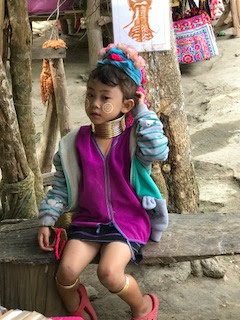 |
| a member of Karen tribe, skilled weavers |
Today we ventured north to visit some of the hill tribes of Chiang Mai where people of Padong, Palong and Karen tribes show off their craft traditions. Northern Thailand is home to interesting and colorful ethnic minorities known as the hill tribes, most of whom have migrated into the region during the past 100 years as the result of being forced out of interior Asia: China, Myanmar, and Tibet. Each of the tribes has preserved their traditional ways and dress, making them a fascinating cultural study.
Most of the hill tribes living in the remote upland areas practice subsistence farming. Until the 1950's, the increase in their population, extreme poverty, and threat of insurgency forced the government to form a National Committee for Hill Tribes. Opium cultivation was a major source of income for many of the hill tribes and the government worked to eradicate this by substituting it with other cash crops such as cabbages and fruits. This was knows as the "Royal Project," and proved to be successful.
Hill tribes are reluctant to integrate into the citizenship and customs of the mainstream Thai society.
 |
| Larry holds up weaving |
The Karen wear woven v-neck tunics and turbans. Unmarried women wear long white v-neck tunics. Originally from Myanmar, they mostly occupy lowland areas, engaging in agriculture, including rice growing.
 |
| Another weaver of the Karen tribe |
 |
| loom weaving |
 |
| male woodcarver of Karen tribe |
 |
| This woman has a grand sense of humor. Check out the wooden whistle she is blowing! |
 |
| A better view of traditional dress |
 |
| Weird rooster |
As we strolled through the village, we visited the school where we found beautiful barefoot children doing their work very comfortably on the floor.
 |
| Larry loves kids |
 |
| Math? Fractions? |
 |
| Shoes are traditionally left outdoors |
We continued our stroll through this pristine village of hill tribes.
 |
| The proverbial money tree! |
The Padaung tribe originated in Thailand and are a sub-group of the Shan, who aren't entirely considered minorities as they have always occupied the areas of northwest Thailand and the Shan states of Myanmar.They speak a dialect similar to Thai and are even known as Thai Yai, having been assimilated into Thai culture. They attract many curious visitors because of their long necked women. A tradition of beautifying women by adding brass rings to their necks has been preserved. The neck appears to be elongated when, in fact, it is the collar bone that is depressed to make room for the rings.
One brass ring is attached around the neck of little girls at the age of 5 and are continually added at intervals until she is grown. They are worn during: work, play, sleep, and bathing. They are taken off once a year to clean the brass rings.
The belief is that the rings make them beautiful.
 |
| Rings are also around the legs |
We enjoyed dinner tonight at the Italian restaurant 4 Seasons. Great fun and much laughter with many new acquaintances. Below are views of this beautiful jungle resort.
 |
| Our "hut" |
 |
view from veranda
|




















































